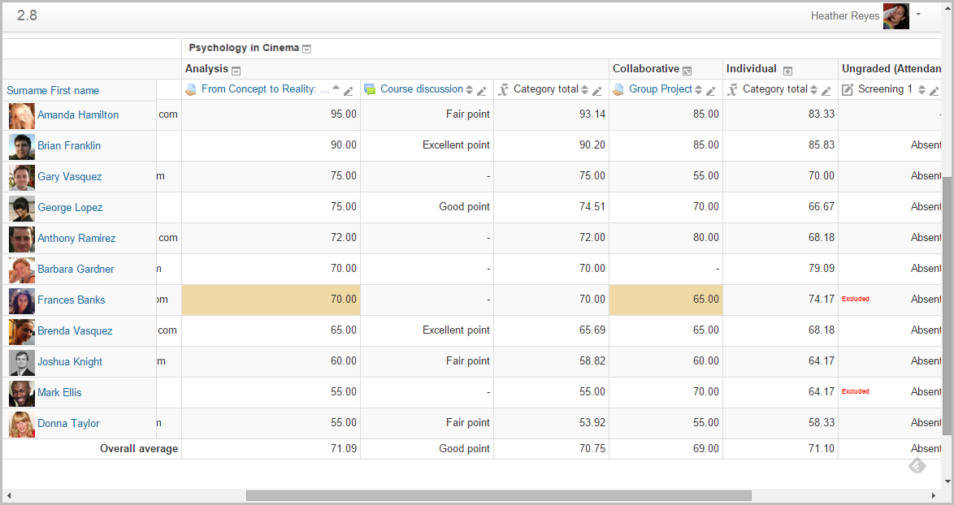Confused about Moodle Grading? In the teaching and learning process grading is an essential component since it informs both students and teachers of their progress in terms of level and provides feedback on the efficiency of the teaching strategies and study aids employed.
Grading activities is an important part of your job as a teacher, but it may be a time-consuming activity. Making grading easier will help you finish other items on your to-do list and save time so you can focus more on planning for future classroom events.
A variety of Moodle activities can be graded (an activity must first be configured as graded). Once a student submits an assignment, the teacher can immediately enter the marks, assessment, or grade to the student from the same activity, and the result is automatically added to the grade book. A column in the gradebook is automatically created for each activity that has been graded. New columns can be manually created and filled with grades and marks.
If there is one feature that distinguishes Moodle, it is the numerous options for creating tests and assessments. Instead of using a grading method just because it is available, it is important to know why you should choose one over the other. The idea here is to create a plan and implement it in Moodle. The platform serves as a tool to help you meet your learning objectives in this way.
Similarly, Moodle provides an essential set of tools for assessing, grading, and evaluating. This means that there are very few platforms capable of competing with Moodle. So, keep this in mind to ensure that you can apply the strategy that best satisfies your objectives.
The Moodle Gradebook: How to Get Started
Your Moodle course assignments, tasks, and/or manual grades are automatically compiled into a single score and piece of feedback in the Moodle Gradebook. Students can check their grades in personalized reports that safeguard student privacy. The gradebook may be displayed to students at certain times and in certain ways, or the instructor may completely hide it.
It is possible for teachers and teaching assistants to manually input and amend grades in the gradebook, and import grades from external sources such as OWL, iClicker, and Opscan. Or export the gradebook to another software program like Excel.
Moodle keeps track of all gradebook modifications so that instructors can verify who made what changes and when. Based on the instructor’s assigned grading scale, the gradebook keeps track of each student’s overall course grade.
Setting Up the Moodle Gradebook

The Moodle gradebook offers a number of features and functionalities that will assist you in navigating to the locations where you need to be in order to do the activities you desire. The gradebook offers a variety of choices for calculating and displaying grades. Your gradebook can be set up in advance of the semester or created as you go.
Setup and Organize Grade Items and Categories
The course gradebook in a Moodle course automatically adds matching grade items (columns) when activities like Assignments or Quizzes are uploaded. In order to record more grade components, Moodle also allows you to manually add columns to your gradebook. It is acceptable to create your gradebook as you go in both of these scenarios, but when it comes to determining final grades, the organization of these factors is necessary to guarantee accuracy.
Calculating Grades
Allowing Moodle to handle calculations is the simplest approach to determining grades. If you need subtotals, Moodle includes built-in computations (aggregations) to figure out the grade for the entire course.
When accrediting grades, Moodle offers three options:
- Natural – the total of all grade values.
- Mean of grades – the total of all grades divided by the total number of grades.
- Custom weights – where weights are assigned as a proportion of the overall grade to certain items or categories.
If you need more operations, you could also make a special formula.
Rubrics and Non-numerical Scales for Grading
Some Moodle activities offer to grade using rubrics and non-numeric scales if you prefer alternate techniques for reviewing student work.
Rubrics are helpful when you want to evaluate student work based on a variety of criteria. When evaluating Assignment activities, you can set a rubric and criteria using advanced grading options, and the rubric will produce an overall grade.
Custom Scales are useful when you want students to view Excellent, Good, Fair, and so on as a grade on an item rather than a numerical number. While non-numeric assessments can be displayed using bespoke scales, the gradebook will still be able to do computations with these items if necessary.
Display Grades in Percentages And Letters
You can choose to display grades to students as a letter, a percentage, or a numeric number by modifying the settings in your gradebook. The Grade type of Points is used by default in Moodle activities, with a maximum grade of 100.
You can alter grade limits on the gradebook Letters tab by matching score ranges to letter grades (e.g., 93.00-100.00 for A). Following that, when grading, input the number that corresponds to the letter grade you want to give (for example, 90 for a B+). Students will see the right letter grade when Moodle generates letter grades since it compares numerical scores to the ranges in the Letters settings.
Although, only numerical scores may be recorded for grade elements connected to Moodle activities. For Moodle in the Cloud, it is no longer possible to manually grade items in Moodle by entering letter grades. Letter grades can be shown to students as a percentage, but instructors must record or import grades as points.
Edit The Activity Name of Every Column In The Gradebook
A new column will be automatically created in the gradebook for a Moodle activity after it has been configured to be graded. The column will have the same name as the activity. If the name is lengthy, only the first 12 characters are shown as the column name. Therefore, it is advised that you give the activities short, distinct titles.
New columns can be manually created and filled with grades and marks. Instead of establishing a new column and entering the results, if at all possible, think about using an assignment.
As you add the graded activities to the course, columns are created in the gradebook to reflect this. For this reason, it is frequently required to afterward arrange the columns in the proper sequence. It is fair to establish categories (from chosen columns) and sort columns into categories if there are several graded activities in the course.
Setting Up An Automated System To Verify For Passing Grades
The learner’s performance can be automatically checked to see if it complies with standards using the gradebook configuration options.
For instance, if all of the assignments have been passed (marked on a pass/fail scale) and the average of all quizzes is at least 80%, the course is considered passed if graded using the 10-point scale. Or the course grade is a letter grade determined by the points earned, but it is only considered successful if the learner has passed all non-differentiated examinations.
A formula can be used to determine the passing grade. The formula is dependent on the display type and the configuration of the course’s total grade
Prepare The Final Grades
You can easily shift grades from the Moodle gradebook to your SPIRE grade roster at the end of the semester. Using a scale of your choice, Moodle will convert numerical grades to letter grades. You can still change grades after importing them into SPIRE before the Registrar approves and receives them.
How Does Grading Work With Moodle?

The gradebook automatically compiles the results of graded Moodle activities. Entries in the gradebook are always numeric so Moodle can simply aggregate grades automatically.
Although this can be changed in the Assignment options for each activity, the default rating for each activity is 100. The weights of individual assignments or groups of assignments can then be adjusted in the gradebook to get the overall grade for the class.
You can create a grading system and use it to display letter grades to students based on percentage. Grading can be fairly simple if you use Moodle techniques. It is possible to grade using your own procedures, although it can necessitate additional processes and workarounds.
Some tasks, like the Turnitin and Moodle assignments, let you apply a rubric or grading form to determine your grade.
Manually added grade items (with the exception of Moodle activities like quizzes or assignments) can be adjusted to allow you to type or import actual letters if you choose to grade exclusively using letters and do not want to enter numerical values. It should be noted that using this method excludes the use of numerical scores and prevents Moodle from calculating an overall course grade.
You can give feedback on the majority of Moodle activities using a (verbal) Scale that includes terms like “outstanding,” “unsatisfactory,” and “satisfactory.” It should be noted that each custom scale value has a number associated with it, so you should consider how those numbers will combine to determine a course’s overall grade.
Students can view written feedback next to their grade if you add it. When grading from within the activity, some activities (including Assignments, Turnitin assignments, Quizzes, and Workshops) have a place for writing written feedback. The gradebook also allows you to add comments for graded objects.
How to Grade your Moodle Assignments: 3 Methods
There are three options for grading systems in the Moodle assignment activity in addition to the standard options like points and scales. “Simple direct grading,” “marking guidelines,” and “rubric” are the three options.
Simple Direct Grading
Simple Direct Grading is by far the simplest to implement. When you create an assignment, this is the default setting. You have the choice of giving an overall score and overall feedback when grading a submission. Even though the simple direct way of grading is straightforward, it depends on the feedback remark box as the main tool for informing students of their areas of strength and weakness in the assignment.
Rubric
The rubric is precisely what it says it is. In your course, you can create a rubric that you can use to grade tasks in Moodle. You will be taken to a screen where you can either start generating a rubric from the beginning or modify the one you have already established as a template once you choose the rubric technique and save your assignment.
When using a rubric to grade work, you can enter feedback at the appropriate criterion level by clicking on the level the student has achieved. If you want to have an area for feedback on the entire assignment or remarks not covered by the rubric, there is also a spot for an overall feedback comment.
Marking Guide
The Marking Guide functions as a halfway point between the rubric and simple direct grading. The marking guide approach enables the mark to be broken up into criteria while still providing direct grading boxes for each criterion, as opposed to having the criteria and levels of the rubric method.
There is a feedback box for each requirement in your marking guide, as well as a direct grading box that allows you to enter the student’s level and your chosen point total.
Final Thoughts On Moodle Grading
Moodle is an extremely adaptable learning platform that lets you select or combine several grading techniques. Grading can be quite simple if you follow the Moodle guidelines. It is feasible to grade using your own procedures, although it can necessitate extra steps and hacks. As you grade on Moodle, we hope that some of these thoughts will be helpful.
Looking to take your Moodle course to the next level? Whether you need some help selecting and configuring new plugins, designing your site or something more complicated, our team of Moodle experts is here to help.




